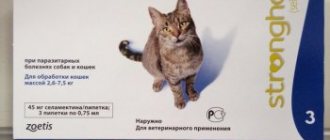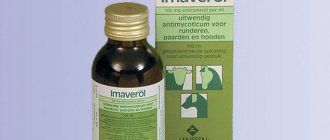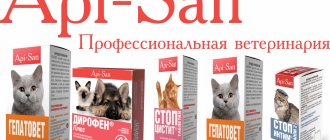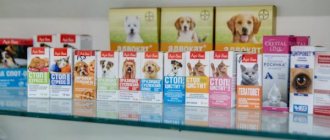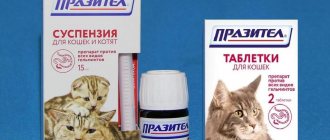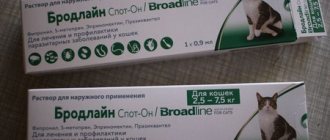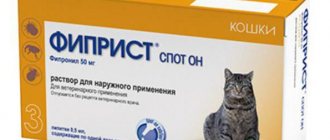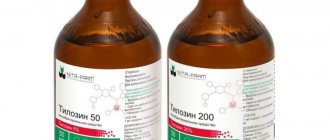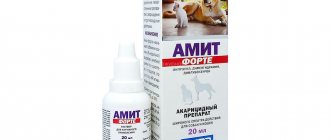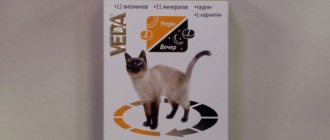Emicidin for cats is a drug that has an antioxidant effect. It is used in veterinary medicine as a therapeutic agent for hypoxia. The medication can be used alone or in combination with other medications. They are also often used as prophylaxis for cardioencephalic syndrome, heart failure, and disorders of blood vessels in the brain.
The drug Emicidin: composition and release form
Emicidin is an antioxidant drug that contains a component such as a derivative of 3-hydroxypyridine and succinic acid, or more precisely, ethylmethylhydroxypyridine succinate. This substance prevents oxygen starvation of tissues and eliminates the harmful effects of free radicals on the pet’s body.
Emicidin capsules are intended for oral administration
The medication is available in the form of capsules and solution. The first form, in addition to the active ingredient, contains gelatin. The solution additionally includes special-purpose water. Capsules should be stored away from heating devices and other heat sources at temperatures from +5°C to +25°C. The drug can be used for treatment within 3 years from the date of manufacture. The storage conditions for the solution are the same, but the shelf life does not exceed 2 years.
Emicidin in the form of a solution is used for injection
At home, without certain skills, it is most convenient to use the drug in capsule form. However, the advisability of using a particular type of medication should be discussed with a veterinarian.
General information
What is it needed for?
- Helps transport oxygen throughout cells if your dog is oxygen starved.
- Reduces the risk of heart disease.
- Reduces harm to the body from chemical and food poisoning.
- Restores the body after severe operations.
- The healing properties of the drug after severe burns.
- Helps restore the body's metabolic processes.
Release form
There are 2 forms of release of this drug:
- The vaccine is a liquid that is colorless and odorless. Available in ampoules from 1 to 10 ml. There are 10 pieces in one box. The concentration of the substance in 1 ampoule is 2.5 or 5%. The composition contains a solution for injection.
- Capsules are hard tablets, elongated in shape. The color of the capsules is divided into half. One half is white, the other is blue, or green, red. Available in 10 or 20 tablets in one box. There are also 30,50,120 and 200 tablets in jars with a lid. One tablet contains 15 mg of active substance. In addition to the active substance, the composition contains talc.
The active substance of two different release forms is the same - ethylmethylhydroxypyridine succinate.
When should emicidin be used?
First, you need to read the instructions for use in detail, which will indicate that it is better to use this drug:
- If your dog is experiencing oxygen starvation.
- Heart diseases in chronic and acute forms.
- If your pet has cardiopulmonary failure.
Below is a list of when you can use the drug with other substances:
- Stressful situations.
- For skin damage (burns, wounds).
- For ulcers that are very difficult to heal.
- In any malfunction of the digestive system.
- As well as dermatitis, necrosis and inflammation, which have passed into the purulent stage. Composition of the device in tablets and vaccine.
Dosage for dogs and puppies
The drug has no restrictions on the age of the dog. You can also administer or give the drug to puppies.
The dose should be calculated by a veterinarian and depends on many indications:
- - weight of the dog;
- - dog problems;
Remember that the dosage is different for different breeds, since all dogs weigh different amounts of kg.
- Small breeds (5 – 10 kg) should be given 1 capsule (15 mg).
- For medium-sized breeds (10 - 30 kg), give 2 capsules (15 mg each).
- Large breeds (30 – 50 kg), for these dogs take 1 capsule of 50 mg.
- And dogs heavier than 50 kg should be given 2-3 capsules with a dosage of 50 mg.
Effect of the drug
The drug combines free radicals and slows down lipid oxidation in tissues.
This circumstance allows the cells to receive more oxygen, which means it creates conditions for the supply of energy to them, which makes it possible to exhibit high activity.
After injection, the body quickly absorbs the active substance and delivers it to the tissues. Oral administration slows down the rate of distribution; maximum activity occurs only after absorption of the component in the stomach. The drug is excreted in the urine after 4-6 hours.
In what cases is medication prescribed?
The drug is prescribed to cats during times of stress, which can be triggered by a sudden change in environment, noisy parties, renovations, etc. The medicine is effective for various types of wounds, frostbite and burns. The medication is used to speed up rehabilitation after surgery, as well as for the treatment of heart failure.
The drug can be prescribed to treat cats during periods of stress
This drug is often prescribed as maintenance therapy for elderly pets. The active component improves the condition of the immune system, stimulates hair growth and relieves the cat of poor health, inhibiting the aging process of the body.
Purpose
Thanks to its antioxidant properties, Emicidin slows down oxidative processes in cells, thereby blocking one of the main mechanisms for the development of pathological processes in the body's systems. Veterinarians use the drug in combination therapy:
- pathological conditions associated with oxygen starvation;
- pulmonary and heart failure;
- chronic cerebrovascular accidents;
- inflammatory processes in the body;
- skin lesions (wounds, eczema, trophic ulcers, dermatitis, etc.);
- diseases of the locomotor system.
In fact, while not being a medicine, Emicidin has good anti-inflammatory and wound-healing effects, due to which the drug is used in the postoperative period to speed up the recovery of the body. In addition, Emicidin before surgery makes it possible to reduce the dose of anesthesia and reduce the risk of postoperative complications.
The use of the drug made it possible to establish one more of its properties: calming. Animals with an unbalanced psyche taking Emicidin tolerate noise effects much easier - they are not afraid of loud and sharp sounds (firecrackers, fireworks, gunshots, thunder, etc.).
Important!
The composition of the drug is as close as possible to natural components, so taking Emicidin does not cause negative consequences and is safe for the animal’s body.
Emicidin can be used as a prophylaxis for pathological conditions or for therapeutic purposes when the disease has been confirmed in clinical tests and the results of other examinations. The drug will help avoid exacerbation of chronic diseases, reduce the number of colds in the autumn-winter period, and increase immunity.
Age-related diseases in cats
Aging is not a disease, it is a biological process that represents a gradual irreversible loss of the body's functionality, a change in its response to external factors and stimuli, resulting in increased vulnerability to disease. Age-related changes affect vital systems of the body: cardiovascular, respiratory, excretory systems, liver and other organs. It is in older animals that the tendency appears:
- to heart pathologies;
- diabetes mellitus;
- thyroid dysfunction;
- osteoarthritis;
- periodontal diseases, etc.
These and other pathologies in cats, which develop more often in old age, are easily treatable in the early stages, but the main danger is that at the very beginning of their development they are practically asymptomatic
Therefore, it is important to regularly visit the veterinarian even with young animals, and even more so when the cat’s age approaches seven years. This will prevent geriatric diseases and prolong the pet’s life without deteriorating its quality.
In old age, Emicidin slows down free radical oxidation in the body. Studies have shown that after just two weeks of using the drug, animals feel better, which also affects the appearance of pets, the quality of their coat, and the cats’ motor activity increases.
The principle of action of Emicidin
The drug helps normalize cerebral circulation and accelerates the delivery of oxygen to tissues. The active component prevents the process of lipid oxidation, which improves the condition of the body as a whole. In addition to these properties, the medication has a positive effect on cell membranes, making them more dense and resistant to hypoxia.
The medicine affects all organs and systems, as it is absorbed into the bloodstream. It has no toxic effects and does not disrupt metabolic processes. In addition, the drug does not affect the intrauterine development of the fetus. The medication has a positive effect on the condition of blood vessels.
The active component is excreted through the kidneys, so if your pet’s organs are not functioning well, you should consult a doctor before starting treatment.
Features of use in cats
The drug in the form of a solution is administered intramuscularly, subcutaneously and intravenously. It is best to entrust the procedure to a specialist. However, if desired, you can administer the injection intramuscularly and subcutaneously yourself. The use of intravenous drips is resorted to only in a hospital setting.
How to administer the medicine intramuscularly:
- It is necessary to prepare a syringe (the shorter and thinner the needle, the better).
- Then you should feel the femoral muscle. At the same time, you also need to determine where the bone is so as not to accidentally hit it. The injection should be given in the middle of the muscle below the hip joint.
- It is recommended to immobilize your pet's leg. Then insert the needle 1 cm into the muscle at an angle of 45 degrees.
- Carefully squeeze out the contents of the syringe. You should not do this too quickly, otherwise the pain may increase.
- Release the pet.
Each new injection should be given to a different limb. It is necessary to avoid the same area, as it can provoke pain. In addition, you cannot use the same syringe, but take a new one each time.
An intramuscular injection should be given to a cat using a short needle.
How to inject the drug under the skin:
- Draw the solution into the syringe in advance in the required quantity.
- Lightly pull the pet's skin in the area between the shoulder blades and secure with two fingers.
- Carefully insert the needle at a 45 degree angle to the spine. If resistance is felt, then you need to stop and continue the manipulation more slowly.
- Then administer the medicine and release the pet.
There is no need to disinfect the skin before manipulation. It is enough that the needle is sterile. It should be remembered that the skin between the shoulder blades is very thick. If you move too quickly, you can bend the needle and cause discomfort to your cat.
A subcutaneous injection involves injecting a solution into the area between the shoulder blades
Attention! During the injection, the pet must be secured so that it does not twitch. In addition, during the procedure you need to remain calm and not raise your tone. Otherwise, each injection for your pet will become a real test and an additional reason for stress.
Capsules are much easier to use for therapy than solution. In this case, the medicine can be pre-diluted with water and given forcibly or added to food. The second method is more effective, and the cat does not experience stress. However, if the animal refuses food in which the medicine is mixed, it is recommended to open the capsule and dissolve its contents in 1-2 tsp. water and put it into a syringe (without a needle!). Then pour in the contents, first opening the pet’s jaws.
A syringe without a needle is best used for oral administration of medication.
The capsule can be given without opening. However, this is quite difficult to do. The fact is that the capsule may stick to the tongue and the pet will try to spit it out, so it is best to administer the medicine using a syringe after first dissolving it in liquid or mixing it into some aromatic dish.
A friend used a similar drug to treat her elderly cat, whose age-related changes had already begun and her heart began to work worse. The pet seemed lethargic and ate little by little. A friend added the contents of the capsule to her food, but the animal did not feel the presence of the drug in the food. After some time, the cat became more active and her appetite improved. The friend is happy with the result, since the pet is almost 17 years old.
How to properly give an injection to a cat - video
Capsules: dosage and regimen
One capsule should be given to your pet once a day, regardless of weight. In this case, taking the drug can be combined with food or the medicine can be given on an empty stomach. The course can vary from 2 to 4 weeks depending on the clinical case. The exact dosage and duration of therapy should be discussed with your veterinarian.
Solution for injection: dosage and treatment regimen
There should be no more than 1 ml of solution per 10 kg of body weight, that is, 2.5–10 mg of active substance per 1 kg. The exact amount is selected by the doctor based on age and weight. Injections are administered 1-2 times a day. The course of treatment varies from 5 to 15 days.
Precautionary measures
Rules that should not be neglected:
- Always use a disposable syringe. You can buy insulin to give injections to cats. This syringe is small in size and has a thin and short needle.
- Do not inject yourself if you lack the skills.
- Do not mix the contents of the capsule with large amounts of food. Otherwise, the treatment will be of no use.
- Do not insert the needle too deeply.
- After the injection, wash your hands thoroughly.
- Keep solution and capsules away from children.
- Before administering the injection, thoroughly disinfect your hands or wear sterile gloves.
- Do not freeze the medicine, otherwise it will lose its properties.
- Avoid getting the solution into your eyes. If this happens, rinse them immediately with plenty of water.
It is recommended to wear sterile gloves before administering the injection.
If you accidentally get an infection when administering an injection, an abscess (a neoplasm filled with pus) may form, which requires long-term and complex treatment.
What is it used for?
The drug is used as an antioxidant. It is also able to saturate cells with oxygen, improving organ function.
Composition and pharmacological properties
The composition of the drug differs slightly depending on the form of release. A small amount of talc is added to the main active ingredient, ethylmethylhydroxypyridine succinate, in capsules, and sterile liquid for injection is added to ampoules.
It is believed that aging and weakening of cells is associated with their damage by free radicals (highly active molecular particles with unpaired electrons on the shell). The active component of the drug has the ability to reduce the concentration of these elements and also prevents their formation.
This fact helps protect cell membranes from particles and relieves tissues from hypoxia. This property of the medicine is used for therapeutic and prophylactic purposes.
Effect of the drug
The drug combines free radicals and slows down lipid oxidation in tissues.
This circumstance allows the cells to receive more oxygen, which means it creates conditions for the supply of energy to them, which makes it possible to exhibit high activity.
After injection, the body quickly absorbs the active substance and delivers it to the tissues. Oral administration slows down the rate of distribution; maximum activity occurs only after absorption of the component in the stomach. The drug is excreted in the urine after 4-6 hours.
Indications for use
The drug can be prescribed for therapeutic or prophylactic purposes. Its main task is to alleviate hypoxia of internal organs and cellular tissues. The main indications when prescribing medication by a veterinarian include:
- Insufficiency of the cardiovascular and pulmonary spheres (in acute or chronic form);
- Wounds, including burns, frostbite;
- Skin problems (dermatitis, eczema, trophic ulcers);
- Inflammatory processes;
- Rehabilitation after surgery, severe health problems;
- Maintaining the health of older animals (over 7 years);
- Stressful conditions (moving, exhibition, competitions);
- Intoxication;
- Pregnancy, postpartum recovery.
The capsule should be placed at the base of the tongue, close the dog's mouth and allow it to swallow the medicine. If necessary, you can give your pet water. The contents of the capsule may be consumed with food. The dosage depends on the dog’s body weight:
| Weight, kg | Single portion | Number of appointments/day |
| From 5 to 10 | 15 mg | 2 |
| From 10 to 30 | 30 mg | 2 |
| From 30 to 50 | 50 mg | 2 |
| Over 50 | 100 mg | 2 |
If emicidin is prescribed for prophylactic purposes, it must be taken once a day. The period of use of the product ranges from 10 to 30 days. The specific period is set by the veterinarian.
The solution can be introduced into the pet's body by drop method, as well as intramuscularly or subcutaneously. The recommended dosage is from 1 to 4 ml of ampoule contents/10 kg (or 2.5-10 mg of active ingredient/1 kg). The frequency of administration is 1-2 times a day for 5-15 days.
For older dogs, when prescribed prophylactically, a single daily dose of 1 ml of solution/10 kg (or 2.5 mg of ethylmethylhydroxypyridine succinate/1 kg) is required. Injections are given twice a year (in autumn and spring), for 10-30 days.
Application for puppies
The drug has no restrictions for use by puppies. The dose of emicidin should be calculated by a veterinarian, depending on the weight of the pet and the existing problem.
Contraindications and side effects for dogs
Emicidin has no contraindications for use. Also, taking it cannot have a negative impact on health.
special instructions
In rare situations, an allergic reaction to the active ingredients of the drug may occur. In this case, it is recommended to stop taking it and provide the animal with an antihistamine.
Analogs
An analogue in composition is Mexidol-Vet, produced in the form of tablets and solution for injection. The latter form is completely similar in its constituent substances to Emicidin, and the capsules, in addition to the same main component, contain several additional ones, which are not present in the drug in question.
They have a different composition, but a similar effect:
- Emidonol is an oral solution or injection version based on 3-(2,2,2-trimethylhydrazinium) propionate-2-ethyl-6-methyl-3-hydroxypyridine disuccinate;
- Apoquel is a tablet version, the active ingredient is oclacitinib maleate;
- Ligfol - the drug contains humic components created as a result of the hydrolysis of wood lignin.
Features of use in pregnant cats and kittens
The drug can only be used in pets whose weight is at least 3–4 kg, so the medication is not used to treat kittens. During pregnancy and lactation, this drug can be prescribed in minimal dosages. The drug can provoke hypersensitivity reactions, so use it with caution during this period and only after prior consultation with a doctor.
For the treatment of pregnant cats, Emicidin is used only in extreme cases.
Attention! If the integrity of the packaging is damaged, then the medication cannot be used for treatment.
Analogs
The therapeutic effect of the drug is similar to vitamin B6 and, in principle, cannot harm the body.
The new generation antioxidant Emicidin has no analogues in composition, but its therapeutic effect is absolutely similar to vitamin B6. It also, if used correctly, is not capable of harming the cat and is often prescribed by veterinary specialists as part of a comprehensive treatment.
The average cost of the drug is as follows:
- capsules (30 pieces, 15 mg each) – 180-220 rubles;
- capsules (30 pieces, 50 mg each) – 280-300 rubles;
- solution 2.5% (10 pcs. 2 ml) – 400-450 rub.;
- solution 2.5% (10 pcs. 5 ml) – 800-860 rub.
The cost of emicidin depends on the volume of the package. Emicidin can be replaced with other antioxidants:
- Mexidol-Vet. Available in the form of tablets (250 or 300 mg, 50 and 125 mg of active ingredient, respectively) and injection solution (25 or 50 mg). The mechanism of action is completely similar to emicidin.
- Emidonol. Solution for oral use 20%, contains 200 mg of emidonol and excipients in 1 ml. Available in plastic bottles of 10 and 20 ml. For veterinary clinics and large enterprises it is bottled in glass bottles of 100 or 250 ml. Also available in plastic bottles of 0.5 and 1 liters and canisters of 2.5 and 5 liters. There is also a 5% injection solution, where 1 ml contains 50 mg of the active ingredient. Bottled in brown glass bottles of 10 and 100 ml. The mechanism of action is similar to the drugs Mexidol-vet and emicidin.
Emicidin is an effective drug that improves the well-being of dogs suffering from oxygen starvation. It has no side effects and a large number of contraindications; it can be used at home, but only after consultation with a veterinarian.
A direct analogue of Emicidin is Mexidol-vet:
- Active ingredient – ethylmethylhydroxypyridine succinate – 25 mg.
- Property – antioxidant, antihypoxant, membrane protector.
- Indications: acute and chronic cardiovascular and cardiopulmonary failure, purulent-inflammatory processes, hypoxia, prevention of anesthesia and post-anesthesia complications, etc.
- No side effects were identified.
- With a significant overdose, weakness and drowsiness may occur.
We invite you to familiarize yourself with Long-haired cats
Note that Emicidin is an analogue of vitamin B6. Naturally, a pure vitamin will not give the same effect, but if there is a shortage of medications, its use is allowed.
This drug does not have absolutely exact analogues. More precisely, there is, but one is pure vitamin B₆, also known as pyridoxine. But it is an analogue not in chemical composition, but in its mechanism of action.
In addition, we would not recommend using pyridoxine constantly and for prophylactic purposes, since in case of an overdose it (like any other vitamin) turns into an extremely dangerous poison.
Adverse reactions and contraindications
Undesirable symptoms when using capsules occur in isolated cases. Most often these are allergic reactions, accompanied by redness of the skin, rashes and itching. If the dosage is followed, there are no adverse reactions in most cases. When injections are administered, a hematoma may form, which quickly disappears after the course of treatment is completed. The drug has no contraindications.
If during treatment the cat’s general health worsens and she becomes lethargic, then you should inform your doctor about this.
Attention! If during treatment your pet's appetite worsens, he becomes apathetic and his behavior changes dramatically, this may be a consequence of a hypersensitivity reaction. It is important to adjust the dosage in time by discussing this issue with your veterinarian.
Instructions for administering the vaccine
- It is necessary to sanitize your hands and wear medical gloves.
- Be careful! The drug can cause allergies not only in dogs, but also in humans.
- Next, you need to open the ampoule and draw the substance into a disposable syringe.
- It is necessary to calm your pet, pay a little attention so that the dog feels calm and there are no sudden movements.
- Disinfect the injection site (withers).
- Inject into the withers and administer the drug.
- The empty ampoule must be discarded with gloves and syringe.
With a capsule everything is much simpler. You can put the tablet in food and check that your pet has eaten it. If this method does not work, then dissolve it in a small amount of water and inject it into the cheek with a syringe without a needle.
Medicines similar in action to Emicidin - table
| Name | Release form | Active components | Indications | Contraindications | Can it be used for pregnant cats? | Price |
| Phytoelite Metastop | Pills |
|
| Individual intolerance to components | Not recommended | From 115 rub. |
| Mexidol Vet | Pills | ethylmethylhydroxypyridine succinate |
| Hypersensitivity to the main component | According to indications | From 478 rub. |
